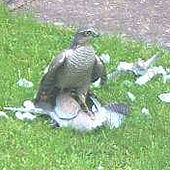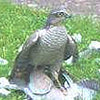In March 2002 I was startled by a commotion in the
garden, following a loud bang as something hit the back door of the house. Birds in the garden
scattered in all directions. I guessed it was a panicking bird
that had hit the door. About three metres away I saw a sparrowhawk
on the ground in the centre of the garden, with its prey - a song
thrush.
I cried out instinctively, and rushed towards it. The sparrowhawk
took fright and flew away, leaving its prey behind. The thrush was
unmarked, but appeared to be gasping its last.
Hardier souls would have left it for the sparrowhawk, which came
back a few minutes later to look for its prey. I'm afraid I couldn't
do that, and had picked up the bird and put it into a box with a
lid straight away (yes, I did happen to have one conveniently in
the shed), in the hope that it might just recover - by some miracle
- in the dark and quiet. It was really hard to close the lid and
just leave it, but I knew that this was the recommended response,
so as not to cause more shock.
Though I have to accept that it's natural, and that the sparrowhawk
needs to eat and feed its young, it was most distressing to witness
a dying song thrush. This is, as far as I remember, only the second
or third time I've actually seen a song thrush in the garden in
five years, and watching a beautiful - and in this area, rare -
bird gasping in shock is a rather traumatic experience.
. . . . .
I first saw a sparrowhawk in the garden in February 1998. My first
sighting was brief - I heard a commotion from the sparrows gathered
in the apple tree as I worked in the garden, and turned around just
in time to see a large bird land, just for an instant, in the middle
of the garden, then take off again. I knew nothing about birds of
prey, but knew that whatever it was had been one.
I have seen the hawk feeding on a bird once, in "woodland
corner" at the far end of the garden. It looked so odd,
massive in the small space. I was struck by its total difference
from any other bird I had seen in my garden. Size, for one. It looked
enormous. Secondly that very obvious hooked beak. And its calmness
and apparent lack of fear. Many birds, particularly sparrows, disappear
at the slightest sound, and seem nervous. This bird seemed to know
it didn't need to be so wary.
Its meal was obviously well under way. I couldn't help but be impressed
by its rather magnificent demeanour, but I didn't watch it eat its
whole meal, as I'm a bit squeamish and pathetic.
A sparrowhawk has returned every now and then in the intervening period,
and killed a bird in the garden, usually in winter. The evidence is usually
just feathers, spread in a rough circular shape.

A sparrowhawk with its prey, in a Leicestershire garden. On this occasion, the prey, a collared dove, got away.
Thanks to Stephen for the photo.

